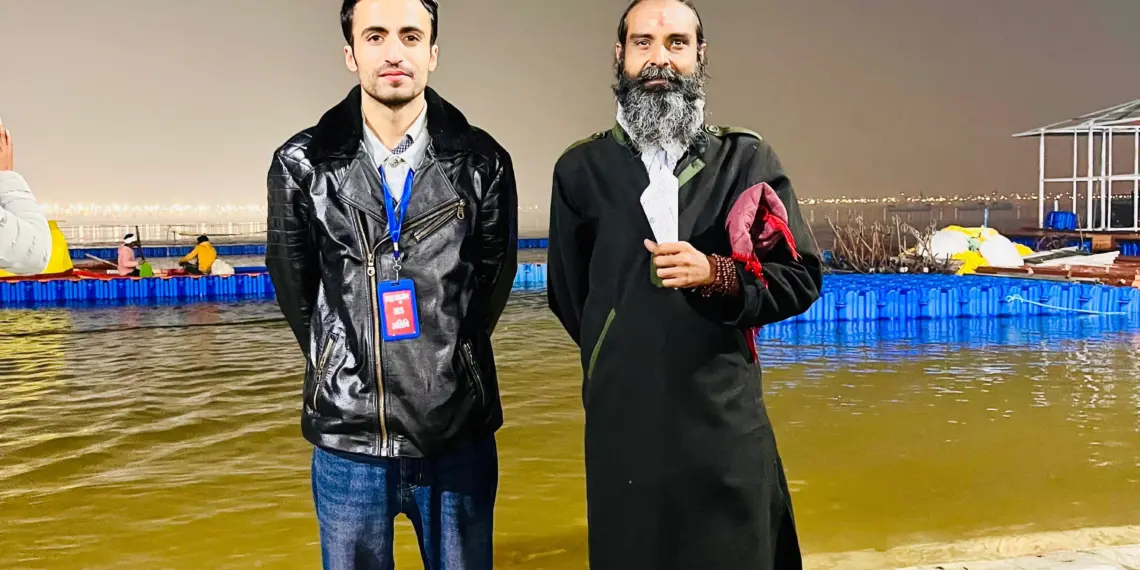As a Kashmiri Muslim, I had always heard stories about the Maha Kumbh Mela—the world’s largest spiritual gathering. Yet, no story or description could have prepared me for the profound experience I had in 2025 when I was invited by my dear friend and brotherly figure, Yuvraj Srivastava, to witness this momentous event in Prayagraj.
Initially, I was hesitant. Coming from Kashmir, a region with its own distinct cultural and religious identity, I wondered if this was an experience I should embark on. But as soon as I set foot in Prayagraj, my doubts melted away. What was meant to be a short two-day visit turned into an unforgettable week. The overwhelming spirituality, the energy of the devotees, and the profound sense of unity I felt made me extend my stay. The atmosphere was so peaceful, devoid of negativity, that I found myself reluctant to return home. However, prior commitments eventually forced me to leave, even though every part of me wanted to stay and immerse myself further in the divinity of the Kumbh.
Arriving at the Kumbh, I was awestruck by the sheer magnitude of the event. Millions of people from every corner of India and beyond had gathered in one place for a shared purpose. It wasn’t just the scale that amazed me but also the seamless blend of faith, tradition, and modernity. From the sacred Shahi Snans (royal baths) to the vibrant Akhara processions, the Maha Kumbh Mela in 2025 was a living testament to India’s rich spiritual heritage.
What struck me even more was the use of cutting-edge technology to enhance the experience. Artificial intelligence played a crucial role in managing crowd movements, and large-scale sustainability initiatives ensured that the event remained eco-friendly. This fusion of ancient rituals with modern advancements showed how tradition and innovation could coexist harmoniously.
Rooted in Hindu mythology, the Kumbh Mela is the world’s largest religious gathering, drawing saints, ascetics, and millions of pilgrims seeking spiritual purification. The 2025 edition was particularly historic due to a rare celestial alignment that occurs once every 144 years. This cosmic event elevated the spiritual and cultural importance of the Kumbh, attracting an even larger number of seekers eager to partake in its divine blessings.
Growing up in Kashmir, I had only heard about the Kumbh Mela through stories. When the opportunity arose, I could not resist—and what an enlightening experience it turned out to be. It was not just a spiritual event; it was an education in devotion, discipline, and unity.
One of the most striking aspects of my visit was the extraordinary level of organization. The Uttar Pradesh government, under the leadership of Chief Minister Yogi Adityanath ji, had made exceptional arrangements to ensure the smooth functioning of this grand event. This was my first visit to Uttar Pradesh, and I was truly impressed by the scale and efficiency of the infrastructure.
The administration’s commitment to cleanliness, safety, and accessibility was evident in every aspect of the Kumbh. Special attention was given to the cleanliness of the Ganga River, which remained pristine despite the massive influx of people. Thousands of sanitation workers were deployed to maintain hygiene, and an extensive police presence ensured the security of all attendees. Yogi Adityanath ji’s leadership in handling such a massive gathering was commendable, from crowd control to ensuring basic amenities with precision and care.
One of the most impressive features was the creation of a temporary city spanning over 4,000 hectares, equipped with 150,000 tents, sanitation facilities, improved transportation services, and medical camps offering free healthcare. I personally experienced this when I felt unwell during my visit. The nearby health facility was well-equipped, and I received treatment without any charge. The professionalism and dedication of the medical staff left me deeply impressed.
Another remarkable initiative was the “Vidya Kumbh” project launched by the Uttar Pradesh government, which provided free education to the children of 15,000 sanitation workers. This initiative highlighted the administration’s commitment not only to organizing the event but also to ensuring the welfare of those working behind the scenes.
As a Kashmiri Muslim, I was welcomed with warmth and respect by the people I met at the Kumbh. Many pilgrims expressed how blessed I was to be part of such a sacred event. The unity, respect, and sense of brotherhood were tangible, and I left Prayagraj with a heart full of gratitude for the kindness I had witnessed.
Reflecting on my time at the Maha Kumbh, I can say that it was an eye-opening experience. The atmosphere of devotion and the sincerity of the devotees left a lasting impact on me. It was incredibly emotional to leave Prayagraj, not wanting to return home. But I am grateful for this once-in-a-lifetime opportunity to witness such a historic event and be a part of it.
For me, the Kumbh was more than just a religious gathering—it was a powerful lesson in human connection, respect for all cultures, and the unifying power of faith. The experience has transformed my perspective and strengthened my belief in the importance of unity, spirituality, and service to humanity.
As a Kashmiri, this journey to the Maha Kumbh Mela was an experience I will cherish forever. Jehanzeb Allaqaband will always carry this experience with him, and as a social activist and youth leader, I am committed to applying the lessons I’ve learned in fostering unity and harmony within my own community. The work done by Yogi Adityanath ji and the Uttar Pradesh government was instrumental in making this grand event a success, and it stands as a model of how public administration can work effectively to serve the needs of millions.


